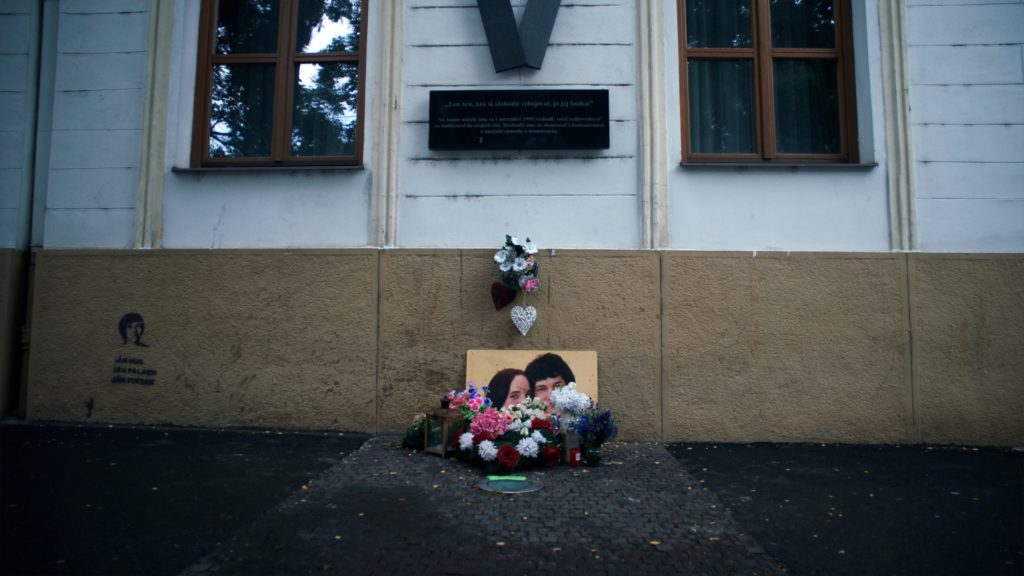Slovakia is a chilling case study. A laboratory of how the corrupt system was built, how it fell, how it broke down into pieces, and how it was rebuilt – tells Pavla Holcova*
What was your thought after watching “The Killing of a Journalist” on a big screen for the first time?
I saw it before it went to the big screen. But when I watched it for the first time in the cinema in Toronto, I was sitting next to my colleague, Eva Kubaniova, with whom we spent many months working on the investigation. She also knew Jan Kuciak. We were sitting in the dark, and when it ended, she turned to me and said – this is the fifth time I saw it. And the first time, I didn’t cry. And it was exactly what I thought.
The story of the Slovak investigative journalist Jan Kuciak and his fiancee Martina Kusnirova’s cold murder is now touching people worldwide. Is it the moment when this journey of the last five years ends?
It is like you are sitting in a cinema and actually watching your life for the last few years. So it is very weird for me to comment on this film because it would be like commenting on the last few years of my life. So, of course, it is not over, and I can’t see the film as it being over. The court trial against Marian Kocner is still ongoing.
We talked shortly after the murder in 2018. From the beginning, you were sure that the murder was linked to Jan’s investigative work. Then you spent many months finding out and exposing the truth. The people who triggered the gun against Jan and Martina are now in jail. But Marian Kocner, a businessman closely linked to Slovak politicians and the judiciary, wasn’t so far sentenced for ordering the killing.
It has many more levels. I believe we have done our best to inform society about the system that enabled Kocner to believe that the murder would go unpunished. I believe we have sent a strong message. If you do harm to a journalist, it would not kill the story. It will only motivate more journalists to expose the truth. It will motivate them to finish all the stories that the journalist who was murdered started.
I believe the trial will eventually bring justice because the case is now much stronger. The court merged the case of Jan’s and Martina’s murder with the case of preparation of another three murders. It shows a pattern and the group of enemies of Marian Kocner. So I’m slightly optimistic that justice will be eventually served.
The murder of Jan and Martina has changed Slovakia. But this change seems fragile.
There was a huge hope after the murder, for two or three years, that society will learn from it and will change. Last year we went to Slovakia with Eva, to conduct a series of interviews with politicians, sociologists, lawyers, and journalists. We asked them a simple question: is the hope still there?
They all agreed it is not there anymore. It has evaporated, it vanished.
Does it mean the corrupt system might go back?
It turned out that the government that replaced the old system is not ready to rule.
The old system was run by one party, SMER. At some point, they split into two parties and those two parties now have around 35 percent and are leading in the polls. The election should be in 2024 – if Slovakia will make it to this time. As it is quite possible that there will be early elections instead, and the old system will come back.
If that happens, can it push back Kocner’s case?
I think it is too late and they will rather sacrifice Kocner. He himself was not such a big player in the system. He just relied on the fact that he knows people and he can buy or influence judges and prosecutors. He had compromats on many of the powerful people.
We could see the scale of this corruption, shady deals, and these compromats thanks to 17 terabytes of data which journalistic investigation “Kocnerova kniznica ” (Kocner’s Library) brought into the light. Are there still stories to be told or do you feel like the full picture of the mafia system was exposed?
This picture is like a blueprint of corruption within the state. And we are not talking anymore about state capture. We are talking about the mafia state, where the Slovak police itself was the most powerful organized crime group. This was exposed. Moreover, it is a database. You can return to the data anytime you need to check if you have a lead and if there is more information.
Kocnerova Kniznica is an unprecedented journalistic investigation in our region. Journalists from eleven Slovak newsrooms got access to the secret room without Wi-Fi, where they could investigate thousands of files. How did it happen?
Probably the crucial element was that majority of these people knew Jano and felt they needed to do something. Those were all journalists, so they were able to talk to each other, share and discuss discoveries. Among this team, we have people from tabloids, from the TV, and at the beginning, it seemed fragile. We couldn’t know if someone, for example, wouldn’t break the deadline or other rules to which we had agreed. We decided with Arpad Soltesz, at that time a director of the Investigative Center of Jan Kuciak, that the two of us will not publish the stories ourselves. We would just enhance the cooperation by telling them that this is not a competition and that we are going to support them to work on the stories. It worked.
Kocnerova Kniznica is like a security belt against this mafia system. As long as it is there, removing this from public memory is impossible.
But people tend to forget. And journalists don’t have any spin doctors, which corrupted politicians can easily hire. So now they just present it as if it is not a comeback of the old system, but a brand new system. They say they don’t agree with corruption, and people forget it were them who were responsible for it. They say they didn’t know who Marian Kocner actually was and that those people who did something wrong are already punished – so everything is fixed.
This is why I believe the film is really important to remind people how the old system worked.
It is also a powerful message for other countries in the region.
As someone not living in Slovakia, I can say this is a chilling case study. There is even a joke that Slovakia is not a country anymore. It is a case study. A laboratory of how the corrupt system was built, how it fell, how it broke down into pieces, and how it was rebuilt and why. I think this universal truth can be applied in many more countries, including, for example, countries from South America.
What lessons come out from this case study? Starting from journalism.
For me, a big lesson was about sharing. Right from the beginning, we had shared the whole drive with Jan to know what was going on in which case. This is why we were able to finish all the stories we started with Jano. Including the story about then Slovak Prime Minister Robert Fico, and his links to the most powerful Italian mafia Ndrangheta, within three days after the murder was discovered.
The killing of Jan and Martina and the murder of Daphne Caruana Galizia in Malta only strengthened international journalistic collaboration and proved that killing a journalist will not kill the story. But what would be the key to a systemic change?
We need to explain better to people what is our role in society because, quite often, they just accept the narrative of politicians that we are here to criticize them and make trouble without knowing the problem. That is not what we do. We are here to inform people to make better decisions in their lives. Of course, many politicians do not like it and would try to silence us.
In the documentary, you say that you always think about whether there would have been anything more to do. But Jan himself never felt threatened, even though Kocner threatened him personally on the phone. How should we treat such threats?
It is the thing I would like to explore more. When we receive a threat, we take it quite often without context. And we should focus more on the context of the threat within the system we live in. So not only to think like this is a powerful shady businessman threatening me, but he would never kill anyone. This is only a tiny part of the risk element. What we really need to consider is how corrupt the judiciary is, and how corrupt is the police. Could he rely on impunity? This is what is happening in Mexico, and this is what happened in Slovakia.
Marian Kocner was sure that the murder would go unpunished because he had prosecutors and judges on his payroll.
Threats for journalists are real. These might be of different shapes, from SLAPPS to Pegasus, to physical and online threats. How to protect journalists more effectively?
We can not protect ourselves, nor can the police protect us. Those who should protect us is society. We saw it after Jano’s murder when people went to the streets and squares and mandate independent investigation. Then they demanded the resignation of the head of the police. Only after this resignation, the independent investigation accelerated. So we need to rely on people who would stand up for us and defend us.
At the same time, we need to fight back if politicians are making us targets.
You were personally targeted by PM Andrej Babis after revealing his shady deals and hidden properties. You fought back and decided to sue him.
He blamed me that I was the one who made him lost the elections. Then the threats began, and it was like a constant stream of hate on all the channels like email, social networks. I first treated it like part of the job. But when he attacked me again, inflicting a new wave of hate, I decided to sue him and use the tools they are using against journalists. I sued him for spreading hate and defamation. In December, there will be a second round of the trial and closing remarks.
Is it something journalists should do more often?
I think that it is something we should do more often. I am not suing him for money; I just want an apology because we really need to show people it is not normal to work in an environment where you are constantly under attack. When someone is constantly threatening you with violence, inventing information about you, and sending you violent images from porn with your name on it. Even if you are quite relaxed and, to some extent, not taking it personally, somewhere back in the brain it is being stored. And then it affects you, causing health issues like stress, lack of sleep, or burnout.
If Babis is forced to apologise, would it also stop his followers on social media?
He’s running for president now. So if he would be forced to say sorry, he would think twice next time before posting hate on his social networks. We ignored it for a long time. We didn’t raise our voices and our concerns. And it was just taken as a new normal.
These last five years since Jan’s and Martina’s murder was a long way to go. The investigation, the trial, the change in Slovakia. How has all this changed your life?
There were a couple of moments when I really felt I can not do it anymore. If I would be a therapist, and someone would come to me and said, I had this friend who was murdered, and I want to investigate his murder and understand how it happened – I would just say no. But we did it, we went through all the reports, interrogations, and autopsy reports.
When it really hit me, it was the moment when Zlata Kusnirova, Martina’s mother, took us to the crime scene, to Velka Maca.
There were jars with vinegar on the stairs. She was explaining where they were building a kitchen, a bedroom, and the toilet. Then she started to show us the places where they were killed. There was still the blood because you can not scrap the blood from between the holes between the tiles. When it is between tiles, it just sank there, and you just can not get rid of it.
Then I asked what these jars with the vinegar are for, and she said – to absorb the smell of the blood.
Everything is still there.
She said – I don’t want this house to be torn down because this is the place where I still talk to Martina. Every time I’m here, and Zlata lives five hundred kilometers from Velka Maca, I need to take something from here, like the sock from laundry.
Both families are absolutely wonderful people. We have also done it for them, to show them we will fight for them and that we will not let it pass the story. The sacrifice of their kids.
I would be happy if I see Kocner sentenced. I think it would be like this moment when both families can say – now we can say goodbye properly.
Pavla Holcova is an investigative journalist and founder of independent outlet investigace.cz, a part of the Organized Crime and Corruption Reporting Project (OCCRP) and a member of VSquare. She has contributed to major cross-border projects such as the Panama Papers, the Russian and Azerbaijani Laundromats, the Pegasus Project, the Pandora Papers, and the Russian Asset Tracker.
Together with her colleague Ján Kuciak, she exposed ties between the Slovak government and Italian mafia. After Ján was murdered, Pavla helped finish his stories, investigate the murder, and, with her team, unravel one of the European Union’s most jaw-dropping corruption scandals, implicating senior judges and police figures and eventually bringing down a government. The story is told in the OCCRP and Final Cut for Real documentary „The Killing of a Journalist.”
Pavla is the winner of the ICFJ Knight International Journalism Award and, with her colleagues Arpád Soltész and Eva Kubániová, the World Justice Project’s Anthony Lewis Prize Award.
The film “The Killing of a Journalist” is taking part in the main competition of the international film festival Watch Docs. Human Rights in Film. Screenings of the film will take place on December 5 and 6 at the Muranów Cinema in Warsaw, it is also available online at mojeekino.pl (only for Polish audience).
After the screening on December 6, we invite you to the debate: Can you kill the investigative story?
Panelists:
The risks and threats for investigative journalism in Central Europe will be discussed by
- Lukáš Diko (Slovakia), editor-in-chief of the Investigative Center of Jan Kuciak (ICJK)
- András Pethő (Hungary), co-founder and head of investigative center DIREKT36
- Anna Gielewska (Poland), co-founder and head of VSQUARE, a regional investigative outlet in Central Europe
Moderator: Beata Biel, head of the Reporters Foundation Council
Anna Gielewska is co-founder and editor-in-chief of VSquare and co-founder of Polish investigative outlet FRONTSTORY.PL. She is also vice-chairwoman of Fundacja Reporterów (Reporters Foundation). A journalist specializing in investigating organized disinformation and propaganda, Gielewska was the John S. Knight Fellow at Stanford University (2019/20) and has been shortlisted for the Grand Press Award (2015, 2021, 2022) and the Daphne Caruana Galizia Award (2021, 2023). She was the recipient of the Novinarska Cena in 2022.








